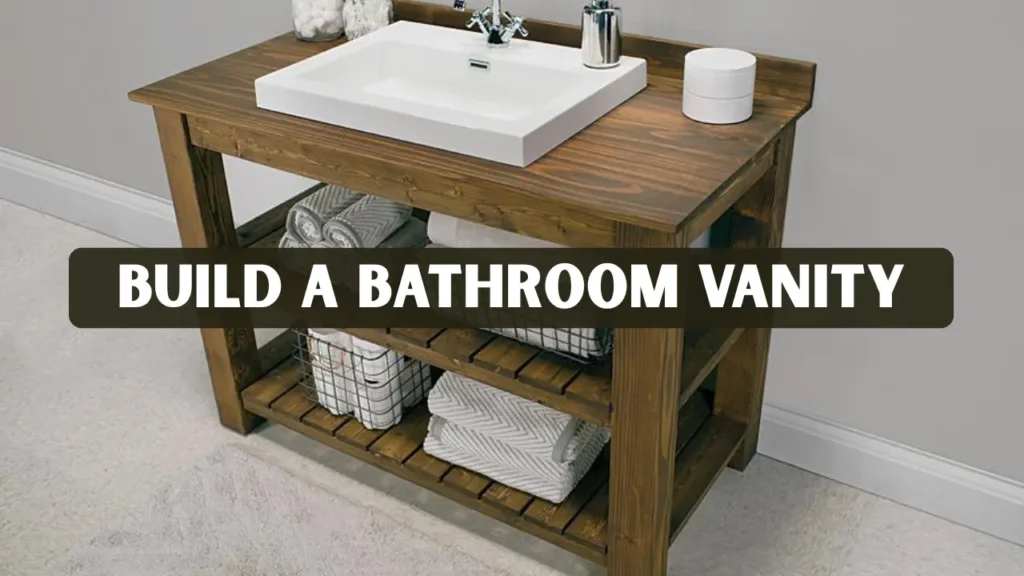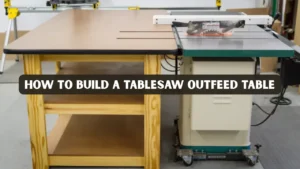Key Takeaways
- Building a bathroom vanity allows you to create a custom fit, unique style, and save hundreds of dollars.
- Planning is crucial: measure plumbing locations, choose moisture-resistant materials, and confirm sink type before cutting.
- The right plywood, finish, and ventilation help build a bathroom vanity that resists water damage and lasts for years.
- The process follows clear steps: frame, carcass, drawers, countertop, finish, and installation.
- Following expert woodworking methods ensures professional results without professional prices.
Why Build a Bathroom Vanity Yourself
A bathroom vanity is one of the most used pieces of furniture in any home. Deciding to build your own offers flexibility that store-bought options cannot provide. You can tailor the size to your exact wall space, select materials that suit your budget, and design the storage layout you prefer. Many DIY enthusiasts report saving 40 to 60 percent compared to retail vanities, especially when using locally sourced plywood and hardware.
This project also provides a great learning experience. It teaches precision measuring, cabinetry assembly, and finishing skills that can be applied to many other woodworking projects. Whether your bathroom is small or spacious, learning how to build a bathroom vanity gives you full control over style and quality.
Planning Your Vanity Project
Before starting, invest time in proper planning. A solid plan ensures smooth assembly and avoids problems with plumbing or fitting once you reach installation day.
Planning checklist
- Measure the available space carefully, including the height from floor to counter and distance from wall to plumbing centerline.
- Record the placement of electrical outlets, mirrors, and lighting fixtures.
- Decide on sink type: drop-in, undermount, or vessel. This affects countertop design and faucet positioning.
- Choose materials: exterior-grade plywood, solid hardwood, or moisture-resistant MDF for body panels.
- Select a finish that complements your bathroom theme.
Proper planning reduces waste and ensures your vanity fits perfectly, especially in tight bathrooms where every inch matters.
Tools and Materials You Will Need
Materials
- ¾ inch exterior-grade plywood for the carcass
- Hardwood or plywood strips for the face frame
- Screws, glue, and pocket-hole fasteners
- Hinges and drawer slides
- Paint, stain, or clear polyurethane finish
- Sink, faucet, countertop, and plumbing fittings
Tools
- Circular or table saw
- Miter saw
- Drill and driver
- Pocket hole jig
- Clamps
- Jigsaw for sink cutouts
- Orbital sander
- Level and measuring tape
Having all materials and tools ready before you begin makes the building process efficient and prevents interruptions.
Step by Step Process
Step 1: Measure and Prepare the Workspace
Every successful project starts with accurate measurements. Determine the total width, height, and depth you want. Standard vanities are usually 32 to 36 inches tall, but you can adjust based on comfort or plumbing height.
Mark the wall centerline for the plumbing drain and note where the hot and cold water supply lines enter. Check for uneven floors or crooked walls, as this will affect leveling later. Use painter’s tape to outline your vanity on the wall to visualize how it fits.
These measurements guide your cut list and help avoid costly mistakes when assembling panels.
Step 2: Cut and Assemble the Carcass
The carcass forms the main structure of the vanity. Cut the plywood panels for the sides, top, bottom, and any internal shelves. Dry-fit them to confirm dimensions before fastening.
Assemble the pieces using pocket holes or glue and screws. Keep everything square by checking diagonals with a tape measure. If the numbers match, your cabinet is square.
Important points
- Always drill pilot holes to prevent plywood splitting.
- Reinforce corners with glue for extra strength.
- Leave an open back or removable panel for plumbing access.
A strong carcass provides long-term durability and ensures drawers or doors align properly once installed.
Step 3: Build the Face Frame and Front Structure
The face frame gives your vanity a polished, furniture-like appearance. Use hardwood or smooth plywood strips cut to size. Join the pieces using pocket holes or dowels and attach the frame to the carcass with glue and clamps.
Tips
- Check alignment before fastening; misaligned frames lead to uneven doors.
- Sand joints smooth before finishing.
- For a modern design, skip the frame and go frameless for a sleek look.
At this stage, test-fit the drawers and doors to make sure they open without rubbing against the frame.
Step 4: Construct Drawers and Doors
Drawers and doors personalize your vanity’s storage. Cut panels for drawer boxes and assemble them using dovetail, box joints, or simple screws and glue. Use full-extension slides to access every corner of the drawer.
Key advice
- Install slides before attaching drawer fronts to ensure smooth operation.
- Use soft-close hinges for doors to add a premium feel.
- Sand all edges and apply wood filler if necessary before painting or staining.
This stage may require some patience. Proper alignment gives your vanity a professional, balanced appearance.
Step 5: Create or Install the Countertop
The countertop is both functional and decorative. You can purchase a ready-made top or craft one yourself. If building, use a durable substrate like plywood sealed with waterproof coating. For a drop-in sink, trace the outline, then cut the opening with a jigsaw.
Always test the sink fit before final assembly. If using stone or quartz, follow manufacturer guidelines for adhesive and sealants. Make sure the faucet holes match your chosen fixture.
Proper sealing prevents moisture from seeping into the wood, which could cause swelling or damage over time.
Step 6: Finishing for Moisture Resistance
Bathrooms are high-moisture areas, so finishing your vanity correctly is essential. Sand all surfaces thoroughly using fine-grit sandpaper. Wipe away dust and apply your chosen finish.
Finishing tips
- Apply primer before painting to prevent moisture penetration.
- For stained finishes, use polyurethane or marine-grade varnish.
- Seal all raw edges, especially around sink cutouts.
- Allow proper drying time between coats for maximum protection.
A well-applied finish not only enhances beauty but also extends the life of your vanity for many years.
Step 7: Installation and Plumbing Connection
Move the vanity into position and check that it sits level. Use shims under the base if the floor is uneven. Secure the vanity to wall studs with screws. Reattach plumbing by connecting the P-trap and supply lines to the sink. Tighten all fittings carefully to avoid leaks.
Run water and check connections before sealing the back or installing drawers. Add a bead of caulk where the vanity meets the wall and backsplash to keep water from dripping behind the cabinet.
Once finished, your custom-built vanity will look just as professional as store-bought models at a fraction of the cost.
How Much Does It Cost
The cost depends on materials and size.
- Budget build: Around $150–$250 using plywood and basic hardware.
- Mid-range build: $400–$800 using hardwood and soft-close hardware.
- High-end build: Over $1,200 with stone top and custom features.
Even with higher material prices, building your own vanity typically costs 30–50 percent less than purchasing a similar quality model from a retailer. Investing time and care pays off in long-term savings.
Design Options and Modern Trends
Modern bathroom designs favor floating vanities, open shelving, and sleek hardware. Traditional styles often use framed doors, panel details, and warm stained wood.
Popular design ideas
- Floating vanity for minimalism and easy cleaning underneath.
- Double sink vanity for shared bathrooms.
- Open shelving for towels and decorative baskets.
- Matte black or brushed brass hardware for contrast.
Adapting your vanity style to your home décor makes the project even more rewarding.
Waterproofing and Durability Tips
Moisture protection is vital for a bathroom environment. Always apply a sealant to exposed wood edges, especially at joints and underneath the countertop. Maintain proper ventilation in the bathroom to minimize humidity buildup.
Avoid these mistakes
- Leaving cut edges unsealed.
- Using non-waterproof glue or finish.
- Failing to caulk around plumbing.
- Ignoring leaks or drips that can damage wood quickly.
A few preventive steps ensure your vanity remains strong and attractive for years.
Troubleshooting Common Issues
Vanity not level: Use a long level and adjust with shims until the surface is flat.
Doors misaligned: Loosen hinges slightly, realign, and retighten screws.
Leaks under sink: Tighten compression fittings carefully without overtightening.
Drawer binding: Recheck slide alignment or adjust screws.
With patience and precise adjustments, small issues can be easily resolved.
Real Example from a DIY Builder
One home renovator recently completed a 30-inch freestanding vanity using birch plywood and pine trim. The total material cost was under $200, including paint and hardware. The builder reported that the project took two weekends: one for construction and one for finishing. With proper sealing and accurate alignment, the vanity has lasted more than three years without any moisture damage or structural problems.
This practical example shows that anyone with basic woodworking skills can successfully build a bathroom vanity and enjoy professional-level results.
Safety Guidelines
Always prioritize safety when working with power tools and finishes.
- Wear safety goggles and gloves.
- Keep your workspace well ventilated, especially during painting or staining.
- Use clamps to hold materials securely while cutting.
- Store paints and sealants away from heat sources.
- Keep children and pets out of the work area until the project is complete.
Following these precautions keeps you safe while achieving clean, professional results.
Conclusion
Learning how to build a bathroom vanity is an excellent woodworking project that balances function, creativity, and savings. With the right materials, careful planning, and proper finishing, your custom vanity will rival any store-bought option. The process offers valuable skills, from precise measuring to applying durable finishes that withstand daily use.
Whether you are renovating your bathroom or starting your first major furniture build, this project provides a rewarding outcome that combines craftsmanship and practicality. Measure twice, work patiently, and enjoy creating a durable centerpiece for your bathroom that reflects your personal style.
FAQs
How long does it take to build a bathroom vanity?
A small single-sink vanity usually takes one weekend, while larger or more complex designs with drawers and custom finishes can take up to two weeks.
What type of wood is best for a bathroom vanity?
Plywood with a hardwood veneer or solid hardwoods like oak, maple, or birch are ideal. They resist moisture better and provide a beautiful surface for finishing.
Can I build a floating vanity?
Yes. Wall-mounted or floating vanities look modern and make bathrooms easier to clean. Make sure to secure them into wall studs to support the weight of the countertop and sink.
How do I keep the vanity waterproof?
Seal every edge with a waterproof primer, use silicone caulk at wall joints, and apply at least two coats of clear protective finish. Regularly check for leaks.
Should I hire help for plumbing connections?
If you’re not comfortable handling water supply or drain fittings, hiring a plumber for the final connection ensures safety and prevents leaks.




